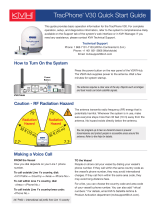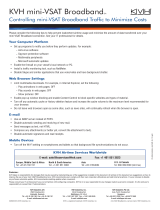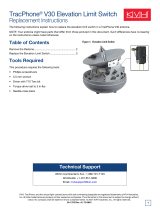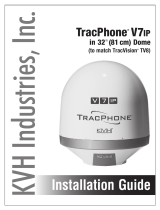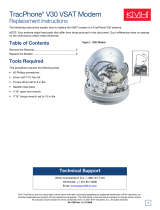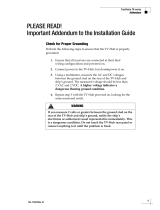Page is loading ...

TracPhone® V30
Installation Guide

© 2021-2022 KVH Industries, Inc., All rights reserved. 54-1371 Rev. E1
TracPhone® V30
Installation Guide
This guide explains how to install the TracPhone V30 mini-VSAT Broadband satellite communications system. Operation
instructions are provided in the Quick Start Guide.
Table of Contents
Important Safety Information............................................. 2
Inspect Parts and Get Tools.............................................. 3
Plan the Antenna Installation ............................................. 4
Plan the VSAT-Hub Installation ......................................... 7
Prepare the Antenna Site .................................................. 8
Prepare the Antenna Cable ............................................... 9
Wire the Antenna ............................................................. 10
Mount the Antenna .......................................................... 11
Mount the VSAT-Hub ...................................................... 13
Wire the VSAT-Hub ......................................................... 14
Connect an NMEA Talker ................................................ 15
Connect Power................................................................ 16
Turn On the System......................................................... 18
Set Up the System .......................................................... 19
Set Up No-Transmit Zones (Optional)..............................23
Test the System ...............................................................24
Configure the Network .....................................................25
Connect the Vessel Phone...............................................26
Educate the Customer .....................................................27
Appendices
Terminating RG-58 Cable ................................................28
Wiring the Antenna Using a Preinstalled Cable ...............31
Connecting Pigtail Cables to the Antenna Cable.............32
Verifying the NMEA 0183 Message .................................33
Wiring Diagram ................................................................34
CAUTION - RF Radiation Hazard
The antenna transmits radio frequency (RF) energy
that is potentially harmful. Whenever the system is
powered on, make sure everyone stays more than
32 ft (10 m) away from the antenna within its
7.7-75° elevation range. No hazard exists directly
above the antenna and anywhere below the
antenna’s mounting plane.
Who Should Install the System?
To ensure a safe and effective installation, KVH
recommends that a KVH-authorized marine technician
install the TracPhone V30 system. To find a technician near
you, visit www.kvh.com/wheretogetservice.
Technical Support
Within Continental U.S.A.: 1 866 701-7103
Worldwide: +1 401 851-3806
Email: [email protected]

TracPhone V30 Installation Guide
2
Important Safety Information
Trademark Information
KVH, TracPhone, and the unique light-colored dome with
dark contrasting baseplate (Reg. No. 2,864,752) are
registered trademarks, and mini-VSAT Broadband is a
service mark, of KVH Industries, Inc.
All other trademarks are the property of their respective
companies.
Disclaimer
Every effort has been made to ensure the correctness and
completeness of the material in this document. No
company shall be liable for errors contained herein. The
information in this document is subject to change without
notice. No warranty of any kind is made with regard to this
material, including, but not limited to, the implied
warranties of merchantability and fitness for a particular
purpose.
Feedback
If you have any comments regarding this manual, please
email them to [email protected]. Your input is greatly
appreciated!
Important Safety Information
This icon indicates a danger, warning, or caution
notice. Be sure to read these carefully to avoid
injury.
WARNING Risk of Electric Shock
If any component of the TracPhone V30
system becomes damaged and/or no longer
functions normally, disconnect it from vessel
power, secure it from unintended operation,
and contact KVH Technical Support (see
“Technical Support” on page 1). All repairs or
modifications must be performed by a trained,
KVH-certified technician. If you are a KVH-
certified technician, you still must contact KVH
Technical Support prior to conducting any
repairs or modifications to the equipment.
WARNING Risk of Explosion
Do not operate the VSAT-Hub (or any other
electrical device) in an environment where
flammable gases, vapors, or dusts are present.
In addition, do not operate the VSAT-Hub in an
environment with a temperature outside its
5º F to 131º F (-15º C to 55º C) temperature
range.
CAUTION Risk of Electric Shock
Failure to ground the TracPhone V30 system
properly to ship’s ground will cause an unsafe
floating ground condition, risking potentially
lethal electric shock. See “Connect Power” on
page 16 for details on the proper grounding of
the equipment.
CAUTION RF Radiation Hazard
The antenna transmits up to 3 watts of radio
frequency (RF) energy that is potentially
harmful. Whenever the system is powered on,
make sure everyone stays more than 32 feet
(10 m) away from the antenna. No hazard
exists directly below the antenna.

3
TracPhone V30 Installation Guide Inspect Parts and Get Tools
Inspect Parts and Get Tools
Before you begin, follow these steps to ensure you have
everything needed to complete the installation.
1. Unpack the box and ensure it contains everything
shown in Figure 1 and on the Kitpack Contents List.
Save the packaging for future use.
2. Carefully examine all of the supplied parts to ensure
nothing was damaged in shipment.
3. Gather the following tools and materials:
• Flat-head and Phillips-head screwdrivers
• Electric drill and 5/16" (8 mm) bit
• 1.5" (38 mm) hole saw
• 1/2" socket and 7/16" socket
• Light hammer and center punch
• Adhesive tape
• Self-vulcanizing tape or equivalent
• Heat gun (for heat shrink)
• Eye protection
•Shop towels
• Voltmeter
• Utility knife
• Flush cutters
• Wire stripper/terminal crimper
• File
• Wi-Fi-enabled laptop PC, or Apple® or Android™
smartphone/tablet with the latest software
downloaded from the KVH Partner Portal
(www.kvh.com/partners), or a smartphone/tablet
with the KVH V30 app installed and loaded with the
latest antenna software
• Cable termination tools, if necessary (see “Prepare
the Antenna Cable” on page 9)
• NMEA 0183 or NMEA 2000 talker and interface
cable (see “Connect an NMEA Talker” on page 15)
Figure 1: TracPhone V30 System Components
IMPORTANT!
Always lift the antenna by the baseplate and never by
the radome or any portion of the internal antenna
assembly.

TracPhone V30 Installation Guide
4
Plan the Antenna Installation
Plan the Antenna Installation
Before you begin, be sure the designated install location
meets the following guidelines.
Choose a Suitable Location
• Select a location that is as close as possible to the
intersection of the vessel’s centerline and midships.
• Temperature must be within the operating range (-30ºC
to 55ºC (-22ºF to 131ºF)).
• Avoid placing the antenna near any magnetic
compasses or other onboard antennas to prevent
potential interference.
• Be sure to mount the antenna near enough to the VSAT-
Hub to allow you to connect the 50 ft (15 m) antenna
cable (supplied in kit) between them, while still
maintaining sufficient slack in the cable.
Note: If you need to use a longer cable, refer to “Prepare
the Antenna Cable” on page 9.
Mounting Structure Requirements
Make sure the mounting surface is flat, level (within ±2º),
and wide enough to accommodate the antenna’s base.
Also make sure that the structure is strong enough to
withstand the weight of the antenna (23.4 lbs, 10.6 kg), as
well as other cumulative forces related to expected
operating conditions, such as ice, snow, wash down, and
maximum expected values of pitch, roll, and wind pressure
(including gusts).
Vibration of the mounting surface should measure less
than 0.51 gRMS total, and also less than 0.11 gRMS at the
following resonant frequencies and axes:
• 23.0 Hz and 43.0 Hz in Horizontal Forward X-Direction
• 26.0 Hz and 66.0 Hz in Horizontal Side Y-Direction
• 50.0 Hz and 76.0 Hz in Vertical Z-Direction
Note: Ship’s crew should consult with the shipyard to
ensure that the antenna mounting surface vibration never
exceeds the above stated conditions at any time during its
life.
Figure 2: Antenna Dimensions
IMPORTANT!
Damage caused by an improper installation is not
covered under KVH warranty.

5
TracPhone V30 Installation Guide Plan the Antenna Installation
Pedestal Structure Requirements
If a pedestal is going to be used, it must meet the following
minimum requirements.
Note: If the pedestal exceeds 3.28 ft (1 m), braces must be
placed at 120° intervals. Sizing is based on Structural Steel
Tubing 60,000 psi (415 MPa) minimum yield. For more
details, refer to the Pedestal Specs Wizard (www.kvh.com/
pedestalspecs).
Note: The ship’s crew is responsible for fabricating and
installing the pedestal.
Figure 3: Pedestal and Brace Dimensions
Pedestal
Height (A)
3.28 ft
(1 m)
6.56 ft
(2 m)
9.84 ft
(3 m)
13.12 ft
(4 m)
Tube OD
(B)
5.0"
(127
mm)
5.0"
(127
mm)
5.0"
(127
mm)
8.0"
(203.2
mm)
Tube Wall
Thickness
(C)
0.25"
(6.35
mm)
0.25"
(6.35
mm)
0.25"
(6.35
mm)
0.5"
(12.7
mm)
Brace
Height (D)
N/A 5.25 ft
(1.6 m)
7.35 ft
(2.24
m)
9.12 ft
(2.78
m)
Brace OD
(E)
N/A 2.25"
(57.15
mm)
4.5"
(114.3
mm)
7.0"
(177.8
mm)
Brace
Thickness
(F)
N/A 0.25"
(6.35
mm)
0.25"
(6.35
mm)
0.25"
(6.35
mm)
Brace
Angle (G)
N/A 25º 25º 25º

TracPhone V30 Installation Guide
6
Plan the Antenna Installation
Prevent RF Radiation Exposure
Select a location that is well above any areas accessible to
passengers and crew to reduce the risk of RF radiation
exposure. (See page 1 for an illustration of the hazard
area.)
If mounting the antenna near an accessible area is
unavoidable, you may configure one or two no-transmit
zones to prevent transmissions in hazardous directions.
(See “Set Up No-Transmit Zones (Optional)” on page 23
for details.)
Minimize Satellite Blockage
The antenna requires a clear view of the sky to transmit
and receive satellite signals. The fewer obstructions, the
better the system will perform.
Figure 4: Blockage from Obstruction
Prevent Electromagnetic Interference
To prevent the antenna from interfering with any
electromagnetic-sensitive compasses or equipment,
maintain a minimum distance of at least 5 ft (1.5 m)
between the antenna and any compasses.
Avoid RF Interference
Although many variables determine the exact distance
required between the antenna and radar/high-power radio
transmitters, including transmitter beam properties and the
reflective properties of nearby surfaces, consider the
following general guidelines:
• Mount the antenna as far away as possible from the
radar and high-power radio transmitters.
• Do not mount the antenna at the same level as the
radar. Most radar transmitters emit RF energy within an
elevation range of -15° to +15°. Therefore, mount the
antenna outside this elevation range and at least 10 ft
(3 m) away from the transmitter.
Figure 5: Avoiding RF Interference
IMPORTANT!
RF emissions from radars and high-power radio
transmitters may damage the antenna or impair its
performance if it’s improperly positioned within the
beam path.
IMPORTANT!
Never place the antenna in the beam path of the radar
regardless of distance. Radar energy may damage the
antenna or impair its performance.

7
TracPhone V30 Installation Guide Plan the VSAT-Hub Installation
Plan the VSAT-Hub Installation
Before you install the VSAT-Hub, be sure the designated
install location meets the following guidelines:
• Select a mounting location in a dry, well-ventilated
area belowdecks away from any heat sources or salt
spray.
• Be sure the location provides adequate Wi-Fi
reception. Do not install it in an area surrounded by
metal or near any electrical devices that emit RF
noise.
• The VSAT-Hub can be mounted horizontally or
vertically on a flat surface.
• Be sure the front panel LEDs will be visible to the
user.
• Select a location that will provide adequate
clearance for the VSAT-Hub dimensions.
• Leave enough room behind the rear panel
(horizontal mount) or below the rear panel (vertical
mount) to accommodate connecting cables and
making service loops, 14" (36 cm) in diameter,
within the proper bend radius. Also consider proper
strain-relief of the connecting cables.
• If you plan to connect the VSAT-Hub to the vessel’s
onboard local area network (LAN), choose a location
near an available Ethernet port.
• To use the supplied antenna cable, the VSAT-Hub
must be located within 50 ft (15 m) of the antenna.
However, you can order a longer cable if necessary.
Note: A template showing the exact locations of the VSAT-
Hub mounting holes and the dimensions between them is
provided in the Welcome Kit. Installation details are
provided in “Mount the VSAT-Hub” on page 13.
Figure 6: VSAT-Hub Dimensions

TracPhone V30 Installation Guide
8
Prepare the Antenna Site
Prepare the Antenna Site
Once you have identified a suitable antenna mounting site,
according to the guidelines provided in “Plan the Antenna
Installation” on page 4, follow these steps to prepare the
site for installation.
1. Unfold the antenna mounting template (supplied in the
Customer Welcome Kit) and place it onto the mounting
surface. Make sure the “FWD” (forward) arrow points
toward the bow and is parallel to the vessel’s
centerline.
Note: You don’t need to mount the antenna exactly on the
vessel’s centerline, but the antenna’s forward arrow must
be parallel to it.
Figure 7: Mounting Bolt Hole Pattern Examples
2. Using a light hammer and center punch, mark the
locations for the four mounting holes and cable access
hole on the mounting surface in the locations indicated
on the template.
3. Drill a 5/16" (8 mm) hole at the four mounting hole
locations you marked in step 2. Later, you will insert
four 1/4"-20 bolts through these holes to secure the
antenna to the mounting surface.
4. Cut out the 1.5" (38 mm) cable access hole in the
location you marked in step 2. Smooth the edges of
the hole to protect the antenna cable. (You may also
apply anti-chafe material around the antenna cable to
prevent abrasion.) Later, you will route the antenna
cable through this hole and into the vessel.
5. Clean and dry the antenna mounting surface.
6. Peel off the paper backing from the supplied foam seal
to expose the adhesive. Then press the foam seal
down firmly onto the mounting surface, ensuring the
hole in the foam seal aligns with the cable access hole
in the mounting surface, as shown in Figure 8.
Note: Apply the foam seal to the vessel mounting surface,
not to the antenna’s baseplate. You will have difficulty
connecting the antenna cable to the antenna if the foam
seal is attached to the baseplate.
Figure 8: Antenna Mounting Holes Layout

9
TracPhone V30 Installation Guide Prepare the Antenna Cable
Prepare the Antenna Cable
You need to connect a single coax cable from the antenna
to the belowdecks VSAT-Hub. KVH recommends using the
supplied 50 ft (15 m) RG-58 cable. However, you may
purchase a different cable for a longer run (see Figure 9 to
determine type of cable and connector required), or you
may reuse an existing cable from a previously installed
antenna unit if it meets KVH requirements (refer to “Wiring
the Antenna Using a Preinstalled Cable” on page 31).
The cable run must meet the following requirements:
• A low-quality, poorly terminated, or improperly installed
cable is the most common cause of system problems.
If the cable is modified for any reason, it must be
terminated again with new connectors, using the
proper tools, exactly to the manufacturer’s
specifications. See “Terminating RG-58 Cable” on
page 28 for instructions for the supplied cable. Only
KVH-authorized marine technicians should modify
the antenna cable, if necessary.
• A new antenna cable must be rated for 50, not 75.
• Use of any cable not specified in Figure 9 or pre-
approved by KVH (refer to “Wiring the Antenna Using a
Preinstalled Cable” on page 31) will void the warranty.
• Make sure the center conductor pin at each end of the
finished cable is free of burrs, as well as the correct
length and diameter specified in Figure 9, to ensure
proper engagement.
• Make sure there is no gap between the end of the cable
jacket and the start of the connector.
• When determining cable lengths, don’t forget to
account for service loops, 14" (36 cm) in diameter, at
each end, and ensure you can maintain the minimum
bend radius (which differs per cable) throughout the
cable run.
• If you use a new LMR-400 cable (or a preinstalled
RG-11, LMR-400, or LMR-600 cable), you need to
connect a pigtail cable between it and the VSAT-Hub.
You may also use a pigtail cable at the antenna end to
maintain proper bend radius. These pigtail cables are
available from KVH. See “Connecting Pigtail Cables to
the Antenna Cable” on page 32.
Figure 9: New Cable Run Options
Note: Cables purchased from KVH include the proper
connectors.
IMPORTANT!
The integrity and reliability of the antenna cable is
critically important. Make certain that the cable is
properly terminated, sealed against seawater and
corrosion, strain-relieved, protected from abrasion, and
free of stress.
RG-58 (50
Max. length 150 ft (45 m)
KVH part nos. 50 ft (15 m): 32-1439-0050
100 ft (30 m): 32-1439-0100
150 ft (45 m): 32-1439-0150
Connector PE4156
Tools Amphenol 47-10070 Crimp Tool,
Steren 204-202 or Hanlong HT-312B
Strip Tool (KVH part no. 72-0982)
Strip lengths
LMR-240 (50
Max. length 300 ft (100 m)
KVH part nos. 200 ft (60 m): 32-1453-0200
300 ft (90 m): 32-1453-0300
Connector EZ-240-TM-X
Tools Times Microwave CT-240 Crimp
Tool, CST-240 Strip Tool, DBT-U
Debur Tool (KVH part no. 72-0949)
Strip lengths
LMR-400 (50
Max. length 400 ft (120 m)
KVH part no. 400 ft (120 m): 32-1441-0400
Connector EZ-400-TM-X
Tools Times Microwave CT-400 Crimp
Tool, CST-400 Strip Tool, DBT-U
Debur Tool (KVH part no. 72-0950)
Strip lengths

TracPhone V30 Installation Guide
10
Wire the Antenna
Wire the Antenna
Follow these steps to connect the antenna cable to the
antenna’s baseplate connector.
Route the Cable Belowdecks
1. Route the opposite end of the antenna cable
belowdecks through the 1.5" (38 mm) cable access
hole. Leave an adequate service loop, 14" (36 cm) in
diameter, at the antenna location for serviceability.
2. Route the cable to the VSAT-Hub location. Always
maintain the minimum bend radius in the cable. Later,
you will connect the cable to the VSAT-Hub.
Figure 10: Minimum Bend Radius
Connect the Cable to the Antenna
1. Clean and dry the antenna cable’s connector and the
connector on the bottom of the baseplate.
Figure 11: Antenna Baseplate Connector
2. Fill half of the inner body of the cable’s male connector
with the supplied silicone grease.
3. Connect and SLOWLY hand-tighten the cable to the
antenna’s connector, allowing the grease to diffuse
and settle into the entire space within the connector.
4. Make sure the cable connector is hand-tightened all
the way into the antenna’s connector.
5. Seal the cable connection with self-vulcanizing tape or
equivalent.
Figure 12: Connecting the Cable to the Antenna
6. Secure the antenna cable near the antenna to relieve
stress.
7. Weatherproof and seal the cable access hole.
Figure 13: Strain-relief (Finished Installation Example)
Cable Type Min. Bend Radius
RG-58 2" (5.1 cm)
LMR-240 2.5" (6.4 cm)
LMR-400 4.5" (11.5 cm)
CAUTION
Be sure to observe the safe handling
instructions in the Material Safety Data Sheet
(MSDS) provided with the silicone grease.

11
TracPhone V30 Installation Guide Mount the Antenna
Mount the Antenna
Follow these steps to first remove the radome and foam
shipping restraints, and then mount the antenna to the
mounting surface.
1. Remove the three #10-32 screws securing the radome
to the baseplate. Carefully lift the radome straight up
until clear of the antenna assembly and set it aside in a
safe place. If you keep the radome topside, secure it
with a lanyard to prevent it from falling overboard.
Note: Due to the snug fit, some contact between the
radome’s sealing gasket and the antenna mechanism is
normal during radome removal and installation.
Figure 14: Remove the Radome
2. Remove the foam shipping restraints and save for
future use.
Figure 15: Remove the Restraints
CAUTION
Once you have removed the restraint(s),
handle the antenna carefully, as its internal
assembly will rotate freely. Whenever you need
to tilt the antenna, be sure to guard against
having the internal assembly swinging around
and potentially crushing your fingers.

TracPhone V30 Installation Guide
12
Mount the Antenna
3. Place the antenna baseplate over the holes drilled in
the mounting surface and make sure the forward arrow
inside the baseplate points toward the bow and is
parallel to the vessel’s centerline. The antenna’s
baseplate should rest squarely atop the foam seal.
Figure 16: Forward Arrow in Antenna Baseplate
4. Apply a thin layer of the supplied anti-seize lubricant to
the threads of the four 1/4"-20 bolts to prevent galling.
5. At each of the two baseplate mounting holes that you
can see without rotating the antenna assembly, place a
5/8" diameter flat washer on a 1/4"-20 bolt and insert
the bolt into the hole from above.
6. Secure each mounting bolt to the mounting surface
using a 1" diameter flat washer and a 1/4"-20 lock nut
from below.
7. Rotate the antenna assembly slowly by hand to reveal
the other two mounting holes then repeat steps 5-6 at
these two holes.
8. Tighten all four bolts until the four rubber feet on the
baseplate are bottomed against the mounting surface
and the foam seal is fully compressed. KVH
recommends that you tighten the nuts to between 25
and 30 ft-lbs (34 and 41 N-m) of torque.
Figure 17: Mounting the Antenna (Side View)
9. Reinstall the radome onto the antenna. Secure in place
with the three #10-32 screws you removed earlier (see
Figure 14 on page 11).
10. Install a protective plastic cap (supplied in kit) over
each radome screw.
CAUTION
Be sure to observe the safe handling
instructions in the Material Safety Data Sheet
(MSDS) provided with the anti-seize lubricant.
IMPORTANT!
Use caution if you’re using power tools. High
installation speeds can damage the threads.

13
TracPhone V30 Installation Guide Mount the VSAT-Hub
Mount the VSAT-Hub
Follow these steps to install the VSAT-Hub inside the
vessel.
1. Before you begin, note the VSAT-Hub’s serial number
provided on a label on the bottom of the unit. You
might need this number later, as it is the default
password for the built-in Wi-Fi.
2. Tape the mounting template in the location selected
for the VSAT-Hub. Punch holes at each of the two
keyhole locations and at the mounting tab location.
Figure 18: VSAT-Hub Mounting Template
3. Remove the template.
4. Drill a 1/8" (3 mm) hole at the three hole locations you
marked in step 2.
5. Install a #8 Phillips thread-forming screw partway into
one of the keyhole holes leaving a small gap for
hooking the VSAT-Hub onto it. Use the thickness
(2.5 mm) of the M10 washer (supplied in kit) as a gauge
for the size gap to leave.
6. Repeat step 5 for the other keyhole.
7. Peel off the backing on the adhesive-backed washer
(supplied in kit) and place it over the mounting tab
hole.
8. Align the wide part of the VSAT-Hub’s keyholes, as
shown in Figure 18, over the screws, then slide
downwards to secure the screws into the narrow part
of the keyholes.
9. Press the rear mounting tab of the VSAT-Hub onto the
adhesive washer and install the third #8 Phillips
thread-forming screw in the mounting tab hole.
IMPORTANT!
Make sure the VSAT-Hub is securely mounted. Any
movement of the VSAT-Hub may put a strain on the
antenna cable’s connection.

TracPhone V30 Installation Guide
14
Wire the VSAT-Hub
Wire the VSAT-Hub
Follow these steps to wire the VSAT-Hub (see page 34 for
a complete wiring diagram).
1. Clean and dry the VSAT-Hub’s “Antenna” connector.
2. Fill half of the inner body of the antenna cable’s male
connector with the supplied silicone grease.
3. Connect and SLOWLY hand-tighten the cable to the
VSAT-Hub connector, allowing the grease to diffuse
and settle into the entire space within the connector.
Do not use a tool or overtighten.
4. Secure the antenna cable near the VSAT-Hub to relieve
stress. Also make sure the cable will not get bent or
twisted near the VSAT-Hub’s connection, which can
put additional stress on the connector.
Figure 19: Antenna Wiring
IMPORTANT!
If you are using an RG-11, LMR-400, or LMR-600
cable, do not connect it directly to the VSAT-Hub.
Connect a pigtail cable between it and the VSAT-Hub.
See “Connecting Pigtail Cables to the Antenna Cable”
on page 32.
IMPORTANT!
Do not connect anything other than the antenna cable
to the VSAT-Hub’s “Antenna” connector. The VSAT-Hub
supplies voltage that will damage other devices.

15
TracPhone V30 Installation Guide Connect an NMEA Talker
Connect an NMEA Talker
The antenna requires a vessel heading input from a
customer-supplied NMEA 0183 or NMEA 2000 talker.
Optionally, you can also provide a vessel position input to
serve as a backup to the antenna’s built-in GPS.
NMEA 0183
1. Connect the NMEA 0183 talker to the 2-position
terminal strip connector (supplied in kit), as shown in
Figure 22. Then plug the connector into the rear panel
of the VSAT-Hub.
2. Configure the NMEA device to transmit one or more of
the supported NMEA 0183 messages at 4800 baud.
3. Make sure the data message(s) includes the
checksum, identifiable by a *xx field at the end of the
data sentence (e.g., $HEHDT,123.4, T*1F). See
“Verifying the NMEA 0183 Message” on page 33 for
details. Do not exceed a 10 Hz input rate.
Note: To supply both the required heading and the
optional position to the VSAT-Hub, you can either connect
an NMEA 0183 talker that transmits both messages, or
connect two devices using an NMEA data multiplexer, such
as Actisense® model NDC-4.
Figure 20: Supported NMEA 0183 Messages
NMEA 2000
1. Connect the VSAT-Hub to the vessel’s NMEA 2000
CAN network backbone via a “T” connector. Be sure
to use a standard drop cable: 5-wire (4 conductors +
shield) twisted pair with micro-C connectors.
2. Configure the NMEA device to transmit one or more of
the supported NMEA 2000 messages.
Figure 21: Supported NMEA 2000 Messages
Figure 22: NMEA Talker Wiring
NMEA 0183 $--XXX Description
Heading Messages
HDG Heading, Deviation & Variation
HDM Heading, Magnetic
HDT Heading, True
OSD Own Ship Data
THS True Heading & Status
VHW Water Speed and Heading
Position Message (Optional)
RMC Position (Optional)
PGN Description
Heading Messages
127250 Vessel Heading
Position Message (Optional)
129029 GNSS Position Data (Optional)

TracPhone V30 Installation Guide
16
Connect Power
Connect Power
Follow the steps in this section to properly ground the
TracPhone V30 system and connect power.
Grounding Requirements
Proper grounding of the TracPhone system to ship’s
ground is mandatory for electromagnetic compatibility
(EMC) and safety regulatory compliance. It protects the
equipment from electrostatic discharges (ESD) and
prevents interference with other electronic equipment.
Follow these steps to ground the system.
1. Connect the hoop of the grounding wire (supplied in
kit) to the “GND” screw on the rear panel of the VSAT-
Hub.
2. Connect the other end of the grounding wire to ship’s
common ground.
Figure 23: Grounding the VSAT-Hub
WARNING
Failure to ground the TracPhone system
properly to the vessel’s ground will cause
an unsafe floating ground condition, risking
damage to the antenna and electric shock,
potentially resulting in DEATH. In a floating
ground condition, the difference between the
equipment's chassis ground and the vessel’s
ground can measure well over 100 volts, when
it normally should not exceed 2 volts.
Therefore, always measure the difference in
potential between chassis ground and the
vessel’s ground to make certain that there is
no dangerous floating ground condition.

17
TracPhone V30 Installation Guide Connect Power
Connect Power to the VSAT-Hub
Follow these steps to connect power to the TracPhone
V30 system.
1. Before you begin, disconnect vessel power and be
sure the vessel is properly grounded in accordance
with marine standards.
2. Connect the supplied power cable wires to the
supplied 2-position terminal strip connector:
• Connect the black wire from “Vin-” on the terminal
strip connector to DC Return.
• Connect the red wire from “Vin+” on the terminal
strip connector to the vessel’s 12 or 24 VDC (160 W
max.) power source.
Note: To connect to AC vessel power, an optional 24 VDC
AC-DC power supply (5A, 160 W) is available from KVH
(part no. 72-0953). Consider installing an uninterruptible
power supply (UPS) between the AC-DC power supply and
vessel power to avoid service interruptions during power
outages and transitions to/from shore power.
3. Insert a fuse (supplied in kit) into the in-line fuse holder.
If vessel power supplies 12 volts, use the blue 15A
fuse. If vessel power supplies 24 volts, use the brown
5A fuse.
4. Connect the terminal strip connector to the
VSAT-Hub’s Power connector.
5. Check for proper grounding by using a multimeter to
measure the AC and DC voltages between the ground
stud on the rear of the VSAT-Hub and ship’s ground.
The measured voltage should be less than
2 VAC and 2 VDC. A higher voltage indicates a
dangerous floating ground condition.
6. Repeat step 5 with the VSAT-Hub powered on, looking
for the same measured result.
Figure 24: Power Wiring
IMPORTANT!
All power connections must be hard wired.
WARNING
If you measure 2 volts or greater between
the ground stud on the rear of the VSAT-
Hub and ship’s ground, notify the ship’s
electrician or authorized vessel
representative immediately. This is a
dangerous condition. Do not touch the
VSAT-Hub rear panel or connect anything to
it until the problem is fixed.

18
Turn On the System TracPhone V30 Installation Guide
Turn On the System
Follow these steps to turn on the system.
1. Ensure the antenna has a clear, unobstructed view of
the sky.
2. Apply vessel power to the TracPhone V30 system.
3. Press the power button on the back of the VSAT-Hub.
The button’s light should illuminate blue.
Figure 25: Power Button
4. Within one minute, the “VSAT-Hub” light will glow
green. Within a few minutes, the “Antenna” light will be
flashing green, indicating the antenna is searching for
the satellite.
Figure 26: Status Lights
IMPORTANT!
During startup, the VSAT-Hub checks the software
version installed in the antenna and updates it if
necessary to match its currently installed version. Do
not turn off the system for at least 15 minutes to allow
any updates to complete.

19
TracPhone V30 Installation Guide Set Up the System
Set Up the System
Follow the steps on the next few pages to access the
setup wizard and configure system for use.
Access the Setup Wizard
Follow the steps for either option below to access the
VSAT-Hub’s setup wizard.
Option 1: Using the Wireless Connection
1. Select the KVHVSAT-<last 3 digits of VSAT-Hub
serial no.> network from your mobile device’s Wi-Fi
settings to connect to the VSAT-Hub.
2. Enter the default password: <full 9-digit VSAT-Hub
serial no.>.
3. Start the web browser and enter
https://kvhonboard.com.
Note: If the setup wizard is not displayed, try entering
http://192.168.5.1, which is the default IP address of the
VSAT-Hub.
Figure 27: Wi-Fi Connection
Option 2: Using the Ethernet Connection
1. Connect a laptop PC configured for DHCP directly to
any “Ethernet” port on the VSAT-Hub.
2. Start the web browser and enter
https://kvhonboard.com.
Note: If the setup wizard is not displayed, try entering
http://192.168.5.1, which is the default IP address of the
VSAT-Hub.
Figure 28: Wired Ethernet Connection
/
